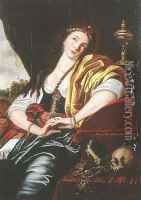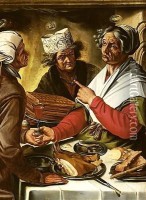Abraham Janssens Van Nuyssen I Paintings
Abraham Janssens Van Nuyssen, also known as Abraham Janssens or Janssen, was a Flemish Baroque painter born in 1567 in Antwerp, which was then part of the Spanish Netherlands. He is known for his historical and mythological scenes, as well as his skill in chiaroscuro and his dramatic use of light and shadow, which reflect the influence of Caravaggio, whose work he may have encountered during his travels in Italy.
After completing his early training in Antwerp, Janssens traveled to Italy, as was common for many Northern European artists of the time seeking to refine their technique and absorb the Renaissance and emerging Baroque styles. He is believed to have visited Rome, which was a center for artistic innovation, and the impact of Caravaggio's work on Janssens is evident in his later paintings.
Upon returning to Antwerp around 1602, Janssens became a master in the Guild of St. Luke, and he began to establish himself as a leading painter in the city. He received numerous commissions from local patrons as well as from abroad, which allowed him to run a large workshop with several apprentices and assistants. His work was marked by a robust and energetic approach, with a focus on strong contrasts of light and dark, dynamic compositions, and a rich palette.
Some of Janssens' notable works include 'The Scaldis and Antwerpia', 'The Crucifixion', and 'The Martyrdom of St. George'. These paintings showcase his ability to convey emotion and drama, as well as his skillful handling of both the human form and the effects of light.
Janssens' career was somewhat overshadowed by the success of Peter Paul Rubens, who returned to Antwerp in 1608 and quickly became the dominant figure in Flemish painting. Despite this, Janssens maintained a successful workshop and continued to receive commissions. He contributed to the flourishing of the Baroque style in the Southern Netherlands and influenced subsequent generations of painters.
Abraham Janssens died in Antwerp in 1632. Although he never achieved the same level of fame as Rubens, his work was important in the development of Flemish painting, and his dramatic use of light and shadow would influence the Baroque artists who followed him.

